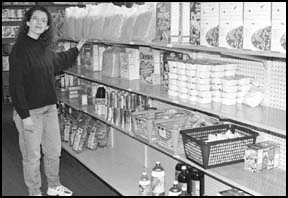 The drive is on to collect food and money for area food shelves during March, which is Minnesota FoodShare Month. All donations made to food shelves during the month are matched by corporations.
The drive is on to collect food and money for area food shelves during March, which is Minnesota FoodShare Month. All donations made to food shelves during the month are matched by corporations.Donna Toney (Paynesville Service Center director pictured at left) said the Feinstein Foundation is matching all donations over $25 in the state of Minnesota. "This is the third year for their donation. It is part of their Hunger in America campaign," Toney added.
According to Catholic Charities, food shelves are overflowing during the holiday season. Traditionally, January has very few donations arrive, yet the number of hungry people remain high (over 500 families). Over 30,000 pounds of food were distributed in January, said Rosanne Healey, Caritas Food Shelf coordinator in St. Cloud.
Minnesota FoodShare reaches out to Minnesota's low-income children and their families, providing them with information on how and where to access the food programs that will help them receive the nutritious food they need to reach their full potential.
Beginning in 1982 as Metro Food-Share, their mission was to meet the unmet needs of the hungry people in the Twin Cities. In 1983, the campaign expanded its focus statewide and became known as Minnesota FoodShare.
In 1999, $4.4 million and pounds of food were raised to help the hungry in Minnesota.
Toney said that 41 percent of the clients that use the Paynesville FoodShelf hold down full-time jobs and occasionally find it hard to make ends meet. "People have this stigma about the food shelf and some people would never come. We try hard to make people comfortable when they ask for help," Toney added.
The Paynesville Service Center serves people from Hawick to St. Martin to Roscoe.
Two fund raisers are planned to help raise funds for the Paynesville Service Center FoodShelf. On March 19 at 7 p.m., the Paynesville UPS employees are hosting "An Evening with the Stars" at Northern Lights. On March 30, Christian vocalist Mitch McVicker will perform at the high school at 7 p.m.
Minnesota FoodShare facts
• In 1998, one in 18 Minnesotans relied on food donations from a food shelf.
•Two-thirds of the households using food shelves included children under the age of 18.
•Of all visits to food shelves in 1998, 12 percent were by people over 62 years old.
•In 1998, food shelves statewide distributed over 24 million pounds of food.
•55,000 children under the age of 12 in Minnesota are hungry, and 144,000 are "at risk" of hunger. •28 percent of food shelf users reported having to choose between buying medication or food; 35 had to choose between housing and food.
Why are so many hungry?
People using food shelves report their income resources are not enough to meet their basic needs. Low wages without benefits, child care expenses, high housing costs, unemployment, and high out-of-pocket medical expenses make working families vulnerable to hunger.
The Personal Responsibility and Work Opportunity Act of 1996 cut $28 billion from the food stamp program over a five year period.
In 1998, the two groups with the highest increase in food shelf usage were senior citizens with high medical costs, and two parent families where both parents were employed at minimum wage jobs, according to Catholic Charities.
Most needed items
According to Catholic Charities, items needed the most at the food shelves are tuna and canned meats, pork and beans, rice, macaroni and cheese, fruits, powdered milk, coffee or tea, canned juices, sugar, canned soups, evaporated milk, canned tomato sauce or paste, peanut butter, jelly, crackers, cereal, canned vegetables, and soup.
Nonfood items needed include bar soap, bathroom tissue, facial tissue, paper towels, laundry detergent, shampoo, toothpaste, dish detergent, lotions, cleaning products, and disposable diapers.